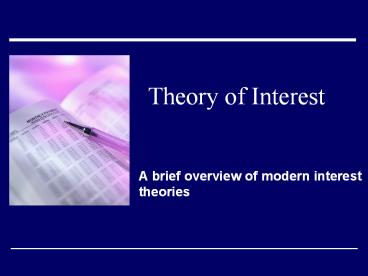Theory of Interest - PowerPoint PPT Presentation
Title:
Theory of Interest
Description:
Fashion. Fisher, Irving. The Nature of Capital and Income. New York: The Macmillan Company, 1906. Octavo, 1st edition in original green cloth. ... – PowerPoint PPT presentation
Number of Views:919
Avg rating:3.0/5.0
Title: Theory of Interest
1
Theory of Interest
- A brief overview of modern interest theories
2
Knut Wicksell (1851-1926)
3
- Born in Stockholm, Sweden, 1851
- Son of a successful businessman and real estate
broker - Orphan at the age of 15
- Mathematics and Physics
- 1887 Economics
- 1898 Interest and Prices
- 1916 Swedish government advisor on financial and
banking issues - main intellectual rival was the American
economist Irving Fisher
4
Interest and Prices
- natural rate of interest vs. money rate of
interest
- real profit (r)
- MPK
- money market (i)
5
Cumulative Process model
- MPK gt i ? I gt S ? M rises
Demand gt Supply ? prices rise
The demand for loans will continue
accumulating, and the banking system's deposit
creation continues indefinitely - with savings
never really catching up. Money supply will
expand endogenously without limit and prices will
also rise without end.
6
What can end this process?
- Reserve Requirement Constraint
7
Irving Fisher (1867-1947)
8
- Born in New York, 1867
- Yale University
- 1888 B.A.
- 1891 Ph.D.
- Mathematics Economics
- 1930 The Theory of Interest
9
The Theory of InterestAs determined by the
impatience to spend income and opportunity to
invest it.
- Income
- Capital
- Interest
10
Income
- 3 stages
- Psychic income or enjoyment income
- Real income
- Money income or cost of living
11
real income
The Thames below Westminsterabout 1871Oil on
canvas 47 x 72.5 cm.
12
Money Income
13
Capital
any asset that produces a flow of income over
time
- The value of any property, or rights to wealth,
is its value as a source of income and is found
by discounting that expected income (Fisher,
1930, p.14). - the value of capital is the present value of the
flow of (net) income that the asset generates
Capital goods
Income
Income value
Capital value
14
Rate of Interest
- capital value X rate of interest interest
- the time preference people have for consuming
today versus consumption at a later time, and - the expectation that income saved and invested
today will yield greater income tomorrow
capital produced today will generate greater
future production than was required to construct
the capital
IMPATIENCE
OPPORTUNITY
15
Difference between Classical economists and
Irving Fisher
- According classical economists there are four
sources of income - Rent
- Wages
- Profits
- Interest
- Fisher treated interest not as a separate entity
of income, but as sub-entity within each of the 3
sources of income
16
Other non-economic factors that influence rate of
interest
- Foresight - intelligence
- Self-control willingness
- Habit
- Life Expectancy
- The love of one's children
- Fashion
17
Fisher, Irving. The Nature of Capital and Income.
New York The Macmillan Company, 1906.Octavo,
1st edition in original green cloth.
1600.Source http//www.manhattanrarebooks.com/f
isher.htm
18
John Maynard Keynes (1883-1946)
19
- Born in Cambridge, 1883
- King's College, Cambridge
- Mathematics in 1905
- Alfred Marshall and Arthur Pigou
- 1936 General Theory
- 1942 was made a lord
- 1944 Bretton Woods Conference
- April 21, 1946 passed away
20
General Theory
- Liquidity-preference
Wealth is allocated between liquid and illiquid
assets
21
- Thus the rate of interest at any time, being
the reward for parting with liquidity, is a
measure of the unwillingness of those who possess
money to part with their liquid control over it.
The rate of interest is not the price which
brings into equilibrium the demand for resources
to invest with the readiness to abstain from
present consumption. It is the price which
equilibrates the desire to hold wealth in the
form of cash with the available quantity of cash
which implies that if the rate of interest were
lower, i.e. if the reward for parting with cash
were diminished, the aggregate amount of cash
which the public would wish to hold would exceed
the available supply, and that if the rate of
interest were raised, there would be a surplus of
cash which no one would be willing to hold.
(Keynes, 1936).
22
Money Demand Theory
- People hold money for three reasons
- Transaction Motive
- Precaution Motive
- Speculation Motive
Uncertainty
Expectation
23
On expectation
- If E(?i) gt 0 ? Md gt 0
- If E(?i) lt 0 ? Md lt 0
Md (E(?i))
24
Interest Rate is a function of money demand and
money supply it is a monetary factor
- i i (Md, Ms)
25
Sir John Hicks (1904 - 1989)
26
Sir John Hicks
- Born in 1904 at Warwick, England
- Mathematics
- Clifton College (1917-22)
- Balliol College, Oxford (1922-26)
- 1937 IS-LM model
27
IS-LM model
- Based on John M. Keyness General Theory
- All equilibria in both commodity and money markets
28
- IS curve Y f(i) ? equality of S and I
- LM curve i f(Y) ? equality of Ms and Md
29
In 1982 Hicks rejected this model because
although it is a very useful apparatus to
understanding Keynes General Theory but it lacks
one very essential thing that Keynes already knew
Uncertainty































